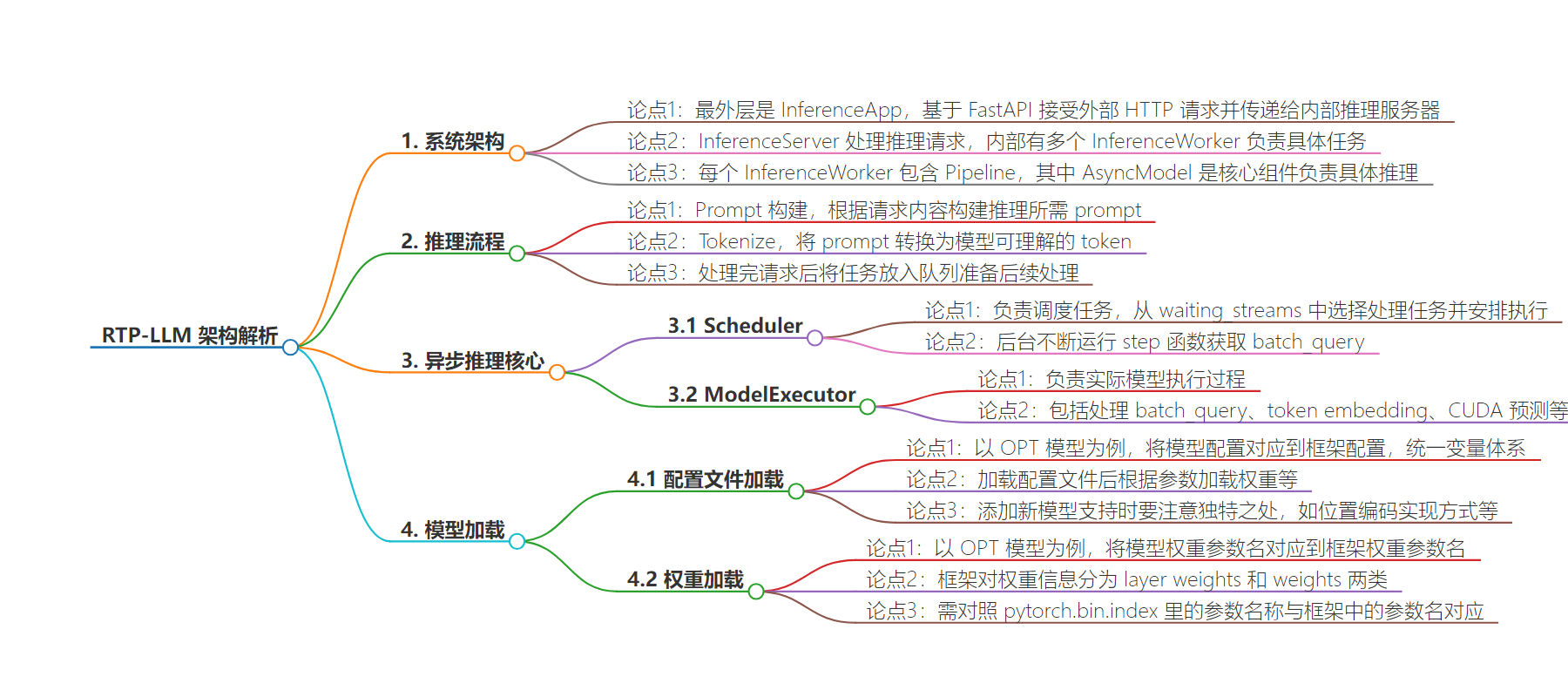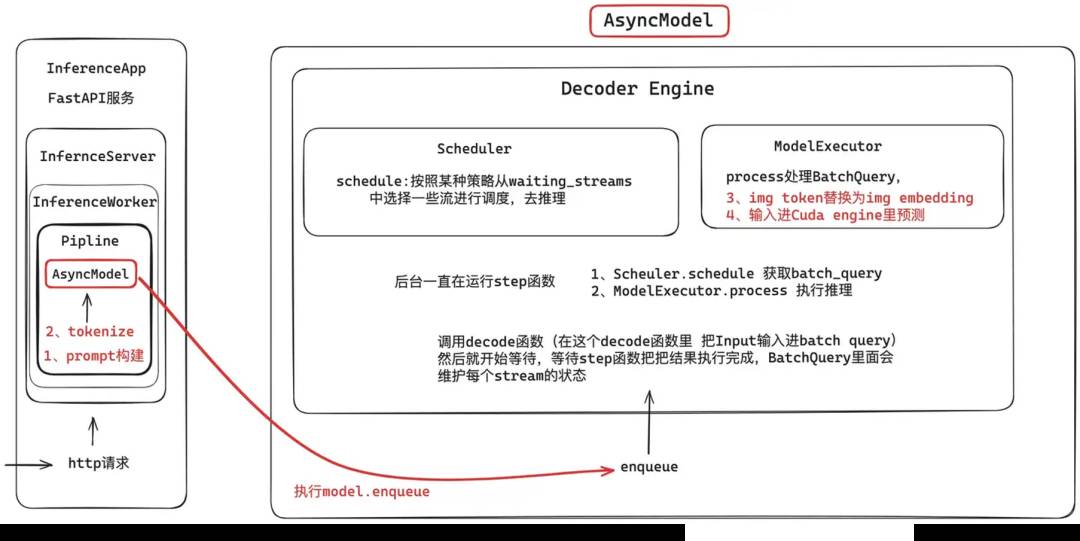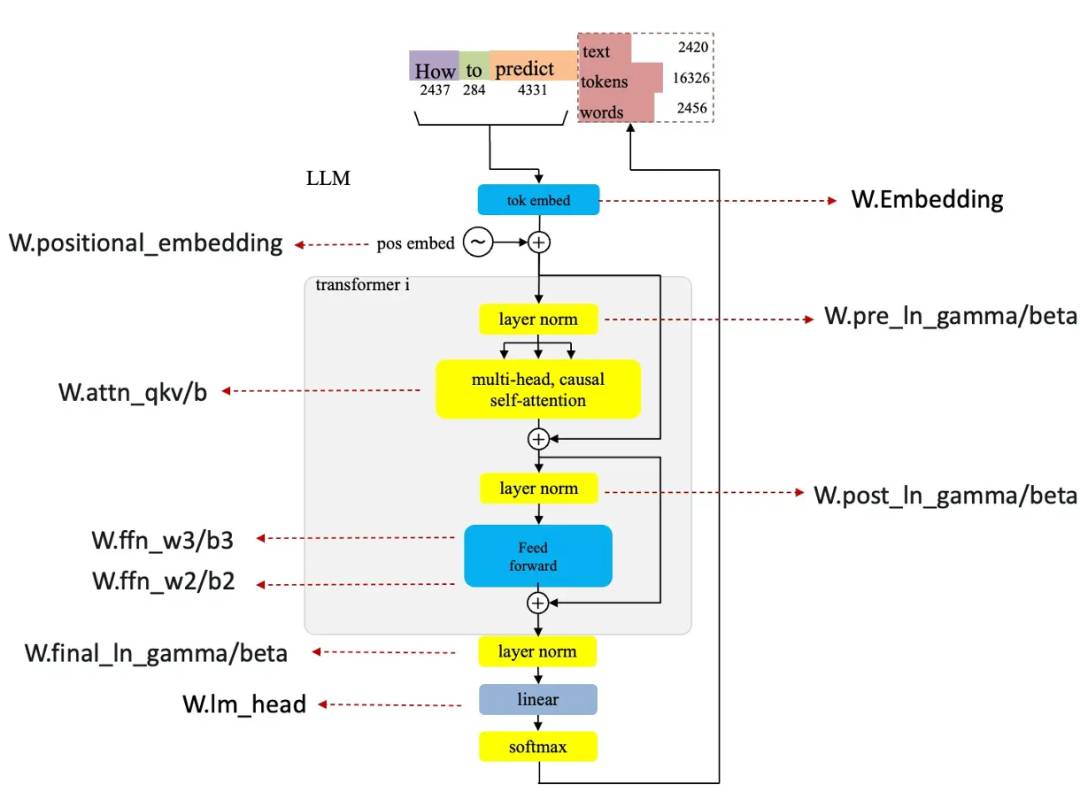包阅导读总结
1. 关键词:
– `RTP-LLM`、`推理框架`、`模型加载`、`配置文件`、`权重`
2. 总结:
文本介绍了大模型推理框架 RTP-LLM 的架构,包括外层的 InferenceApp 和 FastAPI 服务、内层的 InferenceServer 和 AsyncModel 等组件,还阐述了推理任务处理流程。同时,说明了模型加载过程中配置文件和权重的处理方式,以 OPT 模型为例强调了特殊情况和注意事项,并提供了相关代码示例和参数对应关系。
3. 主要内容:
– 大模型推理框架 RTP-LLM 架构
– InferenceApp 和 FastAPI 服务:负责接受外部 HTTP 请求
– InferenceServer 和 InferenceWorker:处理推理请求
– AsyncModel:包含 Scheduler 和 ModelExecutor,负责具体推理任务
– 推理任务处理流程
– Prompt 构建
– Tokenize
– 将任务放入队列
– 模型加载
– 配置文件
– 以 OPT 模型为例,将模型配置对应到框架配置
– 注意模型独特之处,如位置编码实现方式
– 权重
– 以 OPT 模型为例,将模型权重参数名对应到框架权重参数名
– 介绍了框架中 layer weights 和 weights 的划分及对应
思维导图:
文章地址:https://mp.weixin.qq.com/s/TSayGqWUuKO7qQeiT8A2sA
文章来源:mp.weixin.qq.com
作者:RTP-LLM团队
发布时间:2024/9/3 3:17
语言:中文
总字数:3048字
预计阅读时间:13分钟
评分:86分
标签:大模型,推理框架,RTP-LLM,异步模型,模型配置
以下为原文内容
本内容来源于用户推荐转载,旨在分享知识与观点,如有侵权请联系删除 联系邮箱 media@ilingban.com
我们首先对RTP-LLM,该系统由多个层次组成,从最外层的InferenceApp到最内层的AsyncModel,每一层都有特定的职责。

1.1InferenceApp 和 FastAPI服务
最外层是InferenceApp,其核心是一个基于FastAPI的异步服务。这一层负责接受外部的 HTTP 请求,并将请求传递给内部的推理服务器。
1.2InferenceServer 和 InferenceWorker
InferenceServer是实际处理推理请求的服务器,内部有多个InferenceWorker负责具体的任务。每个InferenceWorker包含一个Pipeline,包含了用于处理请求的异步模型AsyncModel。
AsyncModel是整个系统的核心组件,负责具体的推理任务。它包含两个主要部分:Scheduler和ModelExecutor。
当 HTTP 请求到达时,系统会依次进行以下处理:
-
Prompt 构建:根据请求内容,构建推理所需的 prompt。
-
Tokenize:将 prompt 转换为模型可以理解的 token。
处理完请求后,系统会将任务通过model.enqueue放入队列中,准备进行后续处理。
Decoder Engine是异步推理的核心,包含两个部分:Scheduler和ModelExecutor。
Scheduler
Scheduler负责调度任务,它会从waiting_streams中选择需要处理的任务,并安排执行。在后台,Scheduler会不断运行step函数:
-
Scheduler.schedule获取 batch_query。 -
ModelExecutor.process执行推理任务。
ModelExecutor
ModelExecutor负责实际的模型执行过程:
-
Process BatchQuery:处理 batch_query。
-
Token Embedding:将 img token 转换为 img embedding。
-
CUDA 预测:将输入数据送入 CUDA 引擎进行预测。
Decoder函数会调用step函数,将输入数据放入 batch_query,然后开始等待step函数完成推理,并将结果返回。
该框架在模型的加载过程中,通常包含两个核心部分:模型的权重和配置文件。本小节将通过一个具体案例——添加对新模型(如OPT模型)的支持,来详细探讨如何加载模型的配置文件。
首先给出一个最终的配置加载的实现如下, 具体逻辑为将模型的配置对应到框架的配置上, 因为每个模型的配置文件的变量的名字都不尽相同,比如表示transformer模型多头注意力机制的head num的变量名,有的模型可能叫num_attention_heads(opt),有的模型可能叫n_head(starcoder),所以需要对应到框架统一的变量体系下。
classOpt(GPT):"""Opt"""@classmethoddef _create_config(cls, ckpt_path: str):offset = 2config_dict = get_config_from_path(ckpt_path)config = GptInitModelParameters(head_num=config_dict['num_attention_heads'],size_per_head=config_dict['hidden_size'] // config_dict['num_attention_heads'],layer_num=config_dict.get('num_hidden_layers', 12),vocab_size=config_dict['vocab_size'],max_seq_len=config_dict['max_position_embeddings'] + offset)config.layernorm_type = 'pre_layernorm'config.norm_type = "layernorm"config.has_post_decoder_layernorm = Trueconfig.hidden_size = config_dict['hidden_size']config.inter_size = config_dict["ffn_dim"]config.has_positional_encoding = Trueconfig.activation_type = 'relu'config.add_special_tokens = Trueconfig.special_tokens.eos_token_id = config_dict.get('eos_token_id', 2)config.special_tokens.pad_token_id = config_dict.get('pad_token_id', 1)config.special_tokens.bos_token_id = config_dict.get('bos_token_id', 2)config.head_num_kv = config.head_numreturn config在这个框架中,常用的config变量名及其对应的含义如下:
在加载配置文件后,框架会根据这些参数去加载权重等。例如,如果
has_positional_encoding为True,框架会初始化nn.embedding(config.max_seq_len, config.hidden_dim)。当然,还有很多其他操作,这里就不展开了。如果要添加新模型,可以通过对比框架参数和Hugging Face模型文件下的config.json参数来进行编写。1)在编写完新模型的支持代码并加载了模型文件配置之后, 需要确认一下模型是不是按照参数的正常含义去使用的。OPT模型就不是,它有着自己独特的位置编码(Positional Encoding)实现方式, 无论是
position_ids还是nn.embedding,它都统一增加了一个偏移量,让人好一通debug,一直以为是模型权重没加载对,没想到是位置编码出了问题。
因此,当我们要为一个大模型添加新的支持时,要注意他的独特之处,比如位置编码的实现方式、权重的初始化方法、或者是某些特定的层结构。
classOPTLearnedPositionalEmbedding(nn.Embedding):"""This module learns positional embeddings up to a fixed maximum size."""def __init__(self, num_embeddings: int, embedding_dim: int):self.offset = 2super().__init__(num_embeddings + self.offset, embedding_dim)def forward(self, attention_mask: torch.LongTensor, past_key_values_length: int = 0):"""`input_ids_shape` is expected to be [bsz x seqlen]."""attention_mask = attention_mask.long()positions = (torch.cumsum(attention_mask, dim=1).type_as(attention_mask) * attention_mask).long() - 1positions = positions[:, past_key_values_length:]return super().forward(positions + self.offset)
2)
inter_size是一个必须传递的参数,因为它在底层CUDA GEMM算子的执行中起着关键作用。如果忽略了这个参数,底层CUDA GEMM算子将会报错。在本小节中,我们以相同的案例(添加对新模型如的支持),来展开如何加载模型的权重。
首先给出一个最终的模型权重加载的实现如下, 和模型的配置是差不多的,具体逻辑就是将模型的权重参数名对应到框架的权重参数名上, 因为每个模型的权重参数名定义每个都不一样,所以需要对应到框架统一的变量体系下。
classOptWeightInfo(ModelDeployWeightInfo):def _get_weight_info(self):layer_weights = [WeightInfo(W.pre_ln_gamma, [CkptWeightInfo('model.decoder.layers.{i}.self_attn_layer_norm.weight', identity)], identity),WeightInfo(W.pre_ln_beta, [CkptWeightInfo('model.decoder.layers.{i}.self_attn_layer_norm.bias', identity)], identity),WeightInfo(W.attn_qkv_w, [CkptWeightInfo('model.decoder.layers.{i}.self_attn.q_proj.weight', identity),CkptWeightInfo('model.decoder.layers.{i}.self_attn.k_proj.weight', identity),CkptWeightInfo('model.decoder.layers.{i}.self_attn.v_proj.weight', identity),], functools.partial(merge_qkv_hf)),WeightInfo(W.attn_qkv_b,[CkptWeightInfo('model.decoder.layers.{i}.self_attn.q_proj.bias', identity),CkptWeightInfo('model.decoder.layers.{i}.self_attn.k_proj.bias', identity),CkptWeightInfo('model.decoder.layers.{i}.self_attn.v_proj.bias', identity),], functools.partial(merge_qkv_b)),WeightInfo(W.attn_o_w,[CkptWeightInfo('model.decoder.layers.{i}.self_attn.out_proj.weight', identity)], transpose),WeightInfo(W.attn_o_b,[CkptWeightInfo('model.decoder.layers.{i}.self_attn.out_proj.bias', identity)], identity),WeightInfo(W.post_ln_gamma,[CkptWeightInfo('model.decoder.layers.{i}.final_layer_norm.weight', identity)], identity),WeightInfo(W.post_ln_beta,[CkptWeightInfo('model.decoder.layers.{i}.final_layer_norm.bias', identity)], identity),WeightInfo(W.ffn_w3,[CkptWeightInfo('model.decoder.layers.{i}.fc1.weight', identity)], transpose),WeightInfo(W.ffn_b3,[CkptWeightInfo('model.decoder.layers.{i}.fc1.bias', identity)], identity),WeightInfo(W.ffn_w2,[CkptWeightInfo('model.decoder.layers.{i}.fc2.weight', identity)], transpose),WeightInfo(W.ffn_b2,[CkptWeightInfo('model.decoder.layers.{i}.fc2.bias', identity)], identity),]weights = [WeightInfo(W.embedding, [CkptWeightInfo('model.decoder.embed_tokens.weight', concat_0)], identity),WeightInfo(W.positional_embedding,[CkptWeightInfo('model.decoder.embed_positions.weight', identity)], identity),WeightInfo(W.final_ln_gamma,[CkptWeightInfo('model.decoder.final_layer_norm.weight', identity)], identity),WeightInfo(W.final_ln_beta,[CkptWeightInfo('model.decoder.final_layer_norm.bias', identity)], identity),WeightInfo(W.lm_head,[CkptWeightInfo('lm_head.weight', identity)], identity),]return ModelWeightInfo(layer_weights=layer_weights, weights=weights)class OPT_125M(GPT):@staticmethoddef get_weight_cls():return OptWeightInfo
框架中对于权重信息分为了layer weights(对应的是decoder layer的权重参数)和weights(对应的是decoder layer之外的权重参数,比如lm_head、token embedding部分 ), 上图中是框架的参数和模型结构的一个对应,首先我们需要看一下pytorch.bin.index里面的参数名称,然后和框架中的参数名对应上,比如:
WeightInfo(W.pre_ln_gamma, [CkptWeightInfo('model.decoder.layers.{i}.self_attn_layer_norm.weight', identity)], identity),这里W.pre_ln_gamma表示的是Attention和FFN层之前的Layer Norm层,而在OPT模型中,参数名称为model.decoder.layers.
WeightInfo(W.embedding, [CkptWeightInfo('model.decoder.embed_tokens.weight', concat_0)], identity),
这里W.embedding表示的是token的embedding层,在OPT模型中参数名model.decoder.embed_tokens.weight。
https://github.com/alibaba/rtp-llm https://www.zhihu.com/people/66-34-28-46-64/posts https://link.zhihu.com/?target=https%3A//github.com/huggingface/transformers/blob/main/src/transformers/models/opt/modeling_opt.py%23L566

